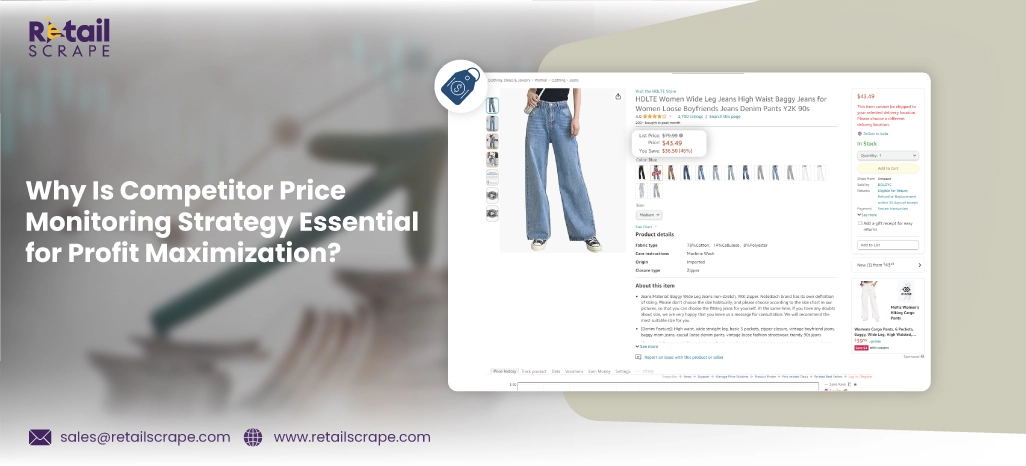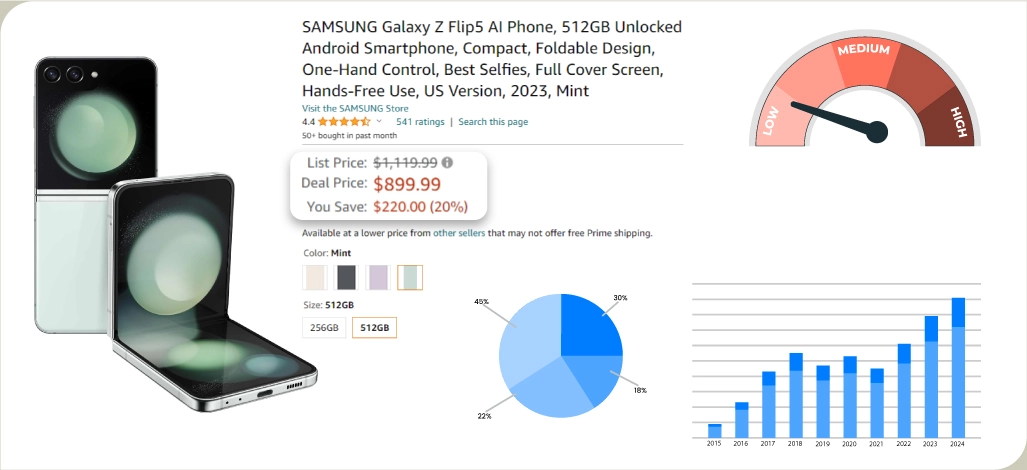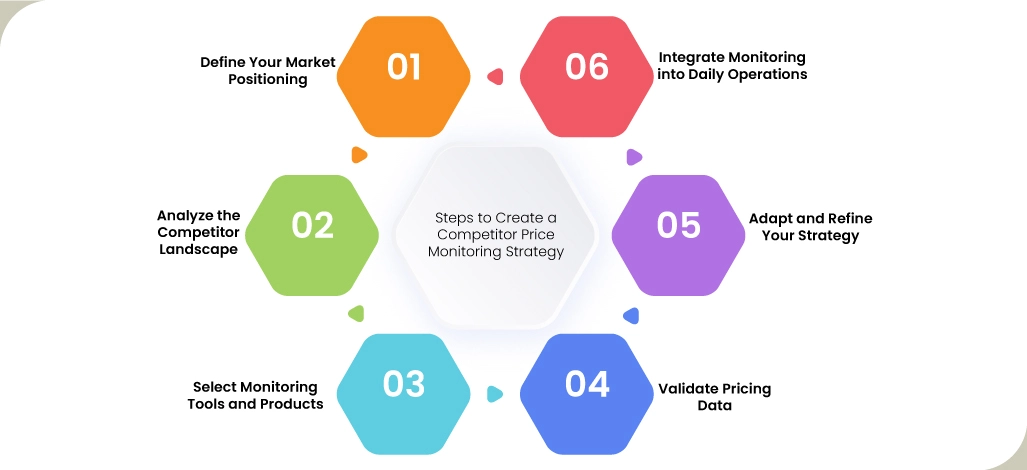 Competitor price monitoring involves systematically tracking and analyzing competitors' pricing strategies within a specific market or industry. This approach is essential for businesses to remain competitive and effectively adapt to dynamic market conditions. By closely monitoring competitor prices, companies gain valuable insights into pricing trends, customer expectations, and competitive positioning.
Competitor price monitoring involves systematically tracking and analyzing competitors' pricing strategies within a specific market or industry. This approach is essential for businesses to remain competitive and effectively adapt to dynamic market conditions. By closely monitoring competitor prices, companies gain valuable insights into pricing trends, customer expectations, and competitive positioning.
Understanding how rivals price their products or services allows businesses to adjust their pricing strategies accordingly, ensuring they remain competitive while maximizing profitability. Moreover, competitor price monitoring helps identify pricing gaps or opportunities for differentiation, enabling businesses to tailor their offerings to more effectively meet the needs of their target audience.
Additionally, this strategy aids in detecting pricing anomalies or fluctuations, which could indicate shifts in market demand, changes in competitor strategies, or emerging competitive threats. By staying informed about competitor pricing, businesses can make informed decisions, refine their pricing strategies, and maintain a competitive edge in the marketplace. Competitor price monitoring is vital for strategic planning and ensuring long-term business success in today's competitive landscape.
Why Is It Essential to Create a Competitor Price Monitoring Strategy?
 In today's fiercely competitive market landscape, businesses must navigate pricing strategies strategically. Establishing a robust competitor price monitoring strategy is pivotal for staying ahead, maximizing profitability, and meeting evolving customer demands.
In today's fiercely competitive market landscape, businesses must navigate pricing strategies strategically. Establishing a robust competitor price monitoring strategy is pivotal for staying ahead, maximizing profitability, and meeting evolving customer demands.
Competitive Advantage: Monitoring competitor prices helps businesses stay competitive by adjusting their pricing strategies accordingly.
Market Insights: It provides valuable insights into market trends and customer expectations, aiding in product development and marketing strategies.
Profit Maximization: Understanding competitor pricing allows businesses to optimize their pricing to maximize profitability while remaining competitive.
Identifying Opportunities: Analysis of competitor prices reveals pricing gaps and opportunities for differentiation, guiding product and service offerings.
Risk Mitigation: Monitoring competitor prices helps detect market fluctuations, enabling timely adjustments to minimize risks and capitalize on opportunities.
Strategic Planning: It informs strategic decision-making by identifying emerging trends, potential threats, and market growth areas.
Customer Perception: Aligning prices with competitors helps maintain customer perception of value and prevents pricing discrepancies that may deter potential customers.
Dynamic Adaptation: This allows businesses to adapt dynamically to changes in the competitive landscape, ensuring long-term viability and success.
Enhanced Performance: Regular monitoring ensures that businesses respond proactively to market changes, leading to improved performance and market positioning.
Sustainable Growth: Businesses can sustainably grow and thrive in competitive markets by staying informed and responsive to competitor pricing.
Crafting a Competitive Price Monitoring Strategy for Retail Success
Understanding consumer behavior and responding effectively to pricing trends is paramount in the dynamic retail realm. Amidst the prevalence of online price comparisons, retailers must adopt a proactive competitor price monitoring strategy. Operating without insight into competitors' pricing landscapes can leave businesses vulnerable to missed opportunities and misaligned strategies.
A comprehensive competitor price monitoring strategy is a guiding compass, illuminating market trends and enabling strategic responses to seize opportunities. Here are four fundamental objectives to shape an effective monitoring strategy:
Precision: Ensure the accuracy and validity of collected pricing data to inform informed decision-making.
Timeliness: Obtain actionable insights promptly to capitalize on market fluctuations and consumer preferences.
Execution: Translate monitored data into actionable strategies, avoiding the pitfall of passive observation.
Competitive Edge: Set objectives aligning price monitoring efforts with broader business goals, such as market expansion or revenue growth.
By embracing a robust competitor price monitoring approach, retailers can navigate the competitive landscape adeptly and position themselves for sustainable success.
Steps to Create a Competitor Price Monitoring Strategy
 Listed below are the steps to create a competitor price monitoring strategy
Listed below are the steps to create a competitor price monitoring strategy
Step 1: Define Your Market Positioning
Before embarking on competitor price monitoring, it's crucial to establish your brand's market positioning. It involves understanding where your products stand regarding quality, exclusivity, and pricing within the market landscape. Clearly defining your market position ensures that the data you collect aligns with your brand's identity and value proposition. With a clear positioning strategy, you can avoid misinterpreting pricing data and making detrimental pricing decisions that could undermine your brand's reputation and profitability.
Step 2: Analyze the Competitor Landscape
Once you've defined your market positioning, the next step is to analyze the competitive landscape. Identify and categorize competitors based on their positioning relative to yours. Create distinct lists for competitors with similar positioning, those with different positioning, and those representing aspirational brands you aim to emulate. Additionally, identify your most significant competitors whose pricing strategies directly impact your business. By studying these different groups of competitors, you can gain insights into pricing trends, competitive pricing strategies, and market dynamics specific to each subset.
Step 3: Select Monitoring Tools and Products
Selecting the proper monitoring tools and products is essential for effective competitor price monitoring. Choose a reliable price monitoring tool that offers automated data collection from competitor websites, comprehensive product information gathering, and customizable monitoring parameters. Determine which specific products or categories you want to monitor based on their relevance to your business and market trends. Ensure that the monitoring tools you choose can provide accurate and up-to-date pricing data to inform your pricing decisions effectively.
Step 4: Validate Pricing Data
Once you've set up your monitoring tools and selected the products to monitor, validating the pricing data collected is essential. Start by testing a subset of critical products to confirm the accuracy and completeness of the data. Analyze the collected data for consistency and relevance and promptly address discrepancies or inaccuracies. Regularly review and validate the pricing data to ensure its reliability and usefulness for making informed pricing decisions.
Step 5: Adapt and Refine Your Strategy
Competitive pricing landscapes constantly evolve, requiring businesses to adapt and refine their monitoring strategies accordingly. Regularly evaluate the effectiveness of your monitoring strategy and be prepared to make adjustments based on changes in market conditions, competitor behaviors, or internal business objectives. Address any challenges or issues encountered during the monitoring process promptly, and continuously refine your strategy to ensure its relevance and effectiveness over time.
Step 6: Integrate Monitoring into Daily Operations
Integrate competitor price monitoring into your daily business operations to derive maximum value. Incorporate regular monitoring sessions into your workflow to stay informed about market changes and competitor pricing strategies. Leverage price intelligence software and tools to receive real-time updates and insights, enabling you to make timely and informed pricing decisions. By integrating monitoring into your daily operations, you can effectively leverage pricing data to maintain your competitive edge and drive business growth in the dynamic marketplace.
Conclusion
Crafting a robust competitor price monitoring strategy is essential for businesses seeking to maintain competitiveness and maximize profitability in dynamic markets. Businesses can gather valuable insights into pricing trends and competitor strategies by defining precise market positioning, analyzing the competitor landscape, and selecting appropriate monitoring tools. It's imperative to validate pricing data regularly, adapt the strategy to evolving market conditions, and integrate monitoring into daily operations for optimal results. Ultimately, a well-executed price monitoring strategy empowers businesses to make informed pricing decisions, capitalize on opportunities, and stay ahead of the competition in today's fast-paced business environment.
Leverage the power of data-driven decisions with Retail Scrape Company. Gain valuable insights into consumer behavior, optimize pricing strategies, and surpass competitors using real-time retail data scraping. Elevate your business with comprehensive pricing optimization and strategic decision support services. Connect with us today to revolutionize your retail operations and maximize profitability!
know more :
https://www.retailscrape.com/competitor-price-monitoring-strategy-for-profit-maximization.php























